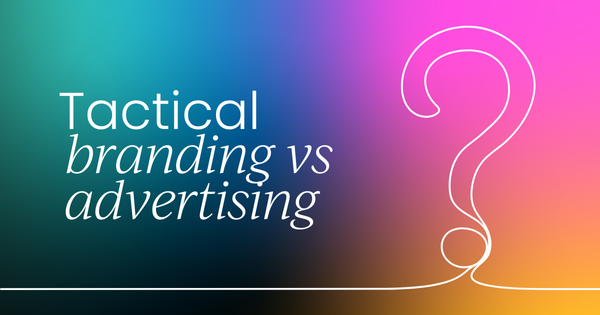Tactical marketing is a rather broad term, covering everything from day-to-day activities to last-minute strategies to achieve all kinds of marketing goals. Unlike strategic marketing, tactical marketing is more short-term, immediate, and fixed.
For customer marketing and advocacy, tactical marketing can be used to support any number of initiatives like segmentation, cross-selling, or up-selling.
In this article, we’ll be going through:
- Tactical advertisements
- Tactical branding
- The differences between the two
Want a definition of tactical marketing and a more in-depth view of its difference from strategic marketing? Take a look at the video below.
Tactical advertising: Engaging your audience
What are tactical ads?
Tactical advertisements, and the broader practice of tactical advertising, refer to a strategic approach in marketing that focuses on short-term, highly targeted campaigns designed to achieve specific and immediate business objectives. This form of advertising is characterized by its agility, precision, and responsiveness to current market conditions or opportunities.
Tactical advertisements are short-term, focused marketing efforts designed to achieve specific, immediate goals.
They typically:
- Promote a particular product, service, or offer
- Have a limited time frame (e.g., seasonal sales, limited-time promotions)
- Focus on driving quick sales or immediate action
- nclude a clear call-to-action (CTA)
- Can be adjusted rapidly based on performance metrics
Examples include flash sales, holiday promotions, or ads for specific product launches.

Eight key elements of tactical ads
Besides the short-term and focused drive, what differentiates tactical ads from the norm? Why make the distinction at all? Well, tactical advertising can help you and your team to balance short-term and long-term brand goals, allocate resources more effectively, and respond to competitors while maintaining brand consistency.
What elements make this possible? Here are the top eight characteristics of successful tactical advertising:
- Targeted messaging: These ads often speak to a specific audience segment with tailored messages that address immediate needs or desires.
- Integration with sales funnel: Tactical ads are frequently designed to move consumers through specific stages of the sales funnel, from awareness to consideration to purchase.
- Data-driven: These campaigns rely heavily on data analytics for planning, execution, and optimization. Real-time metrics are used to fine-tune messaging, targeting, and ad placement.
- Multi-channel approach: Tactical advertising often leverages multiple channels simultaneously, including digital platforms (social media, search engines, display networks), traditional media (TV, radio, print), and direct marketing methods.
- Time-sensitive elements: Many tactical ads include limited-time offers, countdown timers, or seasonal themes to create a sense of urgency and drive immediate action.
- ROI focus: Due to their short-term nature, tactical advertising campaigns are often evaluated based on immediate return on investment (ROI) metrics.
- Creative agility: Tactical advertising often requires marketers and creative teams to produce high-quality content quickly, adapting to current events or trends when appropriate.
- Seasonal and event-driven: Many tactical ad campaigns are tied to specific seasons, holidays, or events, capitalizing on predictable changes in consumer behavior or interests.
Measuring the success of tactical advertising campaigns
As with all campaigns, you’ll want to think carefully about the types of metrics you use to measure and monitor your success.
Taking note of the characteristics above, we’ve found the following metrics to be the most important when it comes to monitoring the immediate success of tactical advertisments:
Sales-related metrics:
- Conversion rate
- Revenue generated
- Sales lift (compared to baseline)
Lead generation metrics:
- Number of leads generated
- Lead-to-customer conversion rate
Website traffic metrics:
- Click-through rate (CTR)
- Bounce rate
- Time on site
Tactical branding: Building a strong brand identity
Definition and importance of tactical branding
While there’s some overlap between tactical marketing and tactical branding, tactical branding promotes and supports your company branding rather than specific campaigns. It prioritizes improving sales and customer engagement in a broader sense.
Tactical branding, refers to short-term branding efforts that aim to reinforce or temporarily shift brand perception. Unlike long-term strategic branding, which focuses on building and maintaining a consistent brand image over time, tactical branding allows for more flexibility and responsiveness in how a brand presents itself to its audience.
This strategy:
- Focuses on brand image rather than specific products
- Aligns with current events, trends, or cultural moments
- Aims to create a temporary but strong brand association
- May not always have a direct sales objective
- Can help a brand stay relevant or demonstrate its values
Examples include holiday-themed logos, cause-related marketing campaigns, or temporary brand partnerships.

Difference between tactical advertising and tactical branding
At a glance, the key distinctions between these concepts are:
- Focus: Tactical ads focus on products/services, while tactical branding focuses on overall brand perception.
- Objectives: Tactical ads aim for immediate sales or actions, while tactical branding aims to influence brand image.
- Longevity: Both are short-term, but tactical branding efforts may have a slightly longer-lasting impact on consumer perception.
- Measurement: Tactical ads are often measured by direct response metrics, while tactical branding might be measured by brand sentiment or awareness.
Both tactical advertisements and tactical branding are part of a broader marketing strategy and can complement each other to achieve both short-term goals and longer-term brand building.
Perks and risks of tactical advertising and tactical branding
Perks
Perks of tactical advertising:
- Messaging: Often product-centric with clear calls-to-action.
- Risk level: Generally lower risk, as it's focused on immediate, measurable outcomes.
- Flexibility: Typically adheres to established brand guidelines.
- Budget allocation: Often has a more direct link between spend and immediate return.
- Cross-functional involvement: Primarily involves marketing and sales teams.
- Success indicators: Success is often clear and quantifiable in the short term.
Perks of tactical branding:
- Timeframe impact: While short-term in execution, tactical branding can have longer-lasting impacts on brand perception.
- Integration with sales funnel: Tactical branding focuses on overall brand positioning.
- Cultural relevance: Often engages with cultural moments, social issues, or current events.
- Content lifespan: Content may have a longer shelf life and could be referenced beyond the initial campaign period.
Risks
Risks of tactical advertising:
- Timeframe impact: Effects are typically immediate but short-lived.
- Integration with sales funnel: Often closely aligned with specific stages of the sales funnel, so if done incorrectly may lead to impacting overall sales success.
- Cultural relevance: May leverage current trends but primarily for product promotion, meaning these adverts will become dated at a quicker rate.
- Content lifespan: Content is usually time-bound and loses relevance quickly after the campaign.
Risks of tactical branding:
- Messaging: More abstract, focusing on brand values, personality, or cultural alignment.
- Risk level: Can carry higher risks, as it may affect long-term brand perception.
- Flexibility: May involve temporary modifications to brand elements (logos, colors, etc.).
- Budget allocation: May require investment without immediate financial returns, focusing on long-term value.
- Cross-functional involvement: Often requires wider organizational involvement, including leadership, as it affects overall brand strategy.
- Success indicators: Success may be more nuanced and take longer to fully manifest.
To conclude
Tactical advertising and tactical branding are two distinct yet complementary approaches in modern marketing strategy. While both are characterized by their short-term focus and agility, they serve different purposes and employ different methodologies.
Understanding the differences between these approaches will allow you to deploy them effectively, either separately or in tandem, to achieve both short-term business objectives and long-term brand building goals.
The key lies in striking a balance between immediate results and sustained brand relevance, using each tactic where it's most appropriate and effective.
Looking to up your brand storytelling or narrative design? We've got a course for that.
Put your best foot forward by tailoring your Narrative Design to show the best parts of you and your product that your customers will actually be interested in. It’s a delicate balance, but Narrative Design Masters has you covered.


 6 min read
6 min read
 Follow us on LinkedIn
Follow us on LinkedIn




